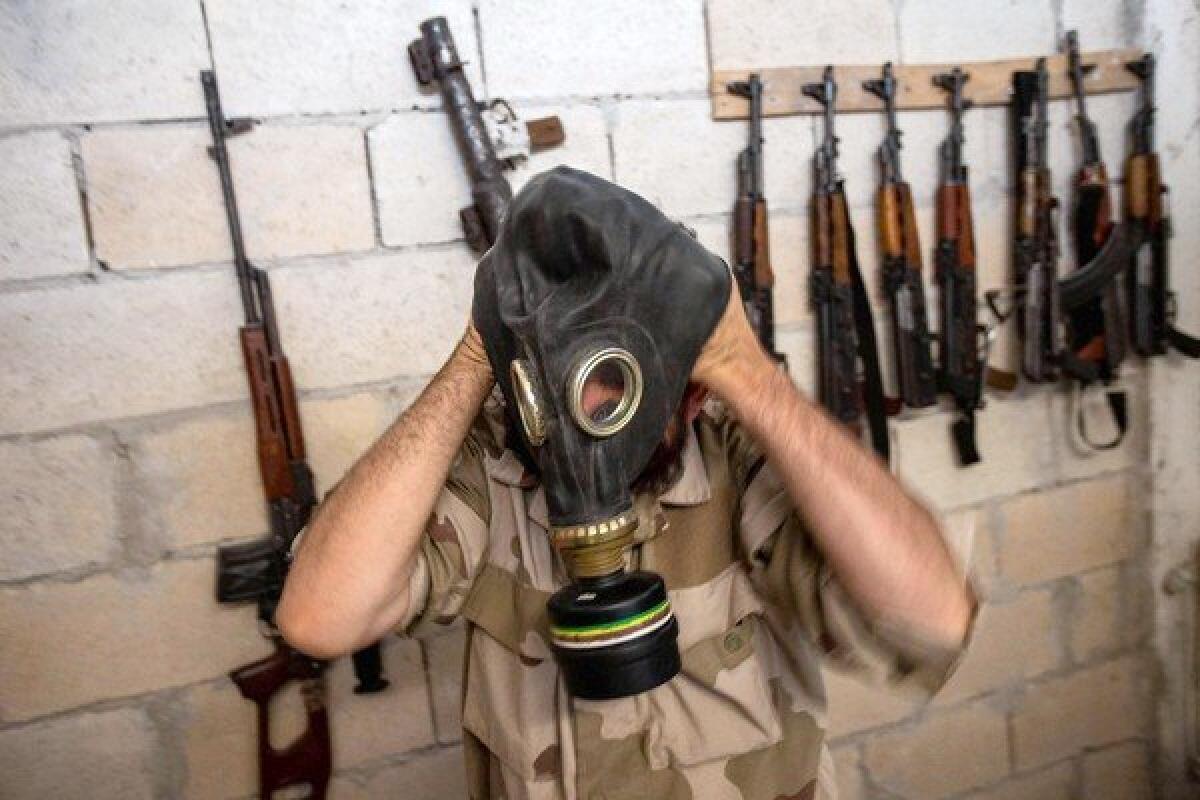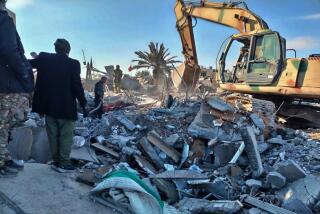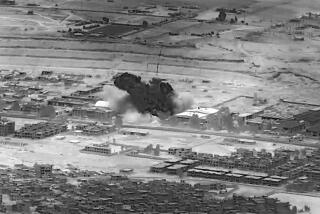U.S. saw yearlong rise in chemical weapons use by Syria

WASHINGTON — In July 2012, senior U.S. intelligence officials drove to the Capitol to secretly brief top lawmakers on the first indications that the Syrian government had used chemical weapons against its own people.
The classified reports about a small-scale attack weren’t definitive, according to U.S. officials who were privy to them. It was still a month before President Obama warned that the use of chemical weapons would cross a “red line” and “change his calculus” about taking action in Syria.
But it was the beginning of a stream of intelligence documenting what U.S. officials say was a yearlong escalation in the use of the banned weapons by the government of President Bashar Assad, a far more extensive record of the incidents than previously known. The Obama administration did not publicly acknowledge the attacks for months, and declared in April that it believed Syria had used chemical weapons.
Obama is struggling to build support now for a punitive strike after an attack Aug. 21 that it says killed 1,429 people. With many of its members deeply skeptical, Congress is expected to begin voting next week on whether to authorize military action.
Administration officials say the evidence for previous chemical attacks wasn’t as compelling, and critics acknowledge it would have been even harder to make the case for a military response to more limited use of the banned weapons. But some current and former officials say the slow response by the White House raises questions about whether earlier, clearer warnings by Obama — and perhaps limited actions such as providing sophisticated weapons to Syrian rebels — could have deterred last month’s attack in Damascus suburbs.
“It’s one of these situations where silence equals consent,” said Jeffrey White, a former Defense Intelligence Agency officer for the Middle East who is now at the Washington Institute for Near East Policy, a think tank.
The Syrian government denies using chemical weapons, saying that would make little sense at a time when it has been retaking territory from the rebels.
But on Wednesday, Secretary of State John F. Kerry told lawmakers that the U.S. knew of 11 chemical weapons attacks by the Syrian government before the August incident, more than double the number the administration had divulged previously. The U.S. believes 150 people or more might have been killed in those attacks, officials say.
“The president didn’t believe it was a compelling enough case to win the support of the American people and the world,” Kerry said when asked why Obama didn’t take military action in April.
Rep. Mike Rogers (R-Mich.), who chairs the House intelligence committee, said in an interview that the Obama administration should have responded more forcefully to the earlier attacks in an effort to deter further use of chemical weapons.
“All the forensic evidence, everything you see with this attack, we had with previous attacks,” said Rogers, who receives regular intelligence briefings and works closely with the administration even as he often criticizes it.
“The only difference is, this one was on the front page of the newspaper,” Rogers said. “That is a horrific standard.... We dithered, and the result is you get the front-page attack and we get to see hundreds of dead children.”
As reports of chemical weapons attacks accumulated in 2012 and early 2013, some officials within the government felt that the White House, recalling the intelligence failures that led to the Iraq war and reluctant to get involved in Syria, was insisting on an unrealistic standard of proof.
“Some of us were convinced,” said a recently retired senior military officer involved in top-level discussions with the White House on Syria. “Others, carrying the extreme level of proof required after Iraq, did not think it met their level of confidence.” The officer, like others interviewed for this report, spoke on condition of anonymity when discussing classified intelligence.
Administration officials say the evidence on the previous attacks was not as strong, and was hampered by spotty intelligence coverage of Syria.
“Syria is a very challenging intelligence environment,” said a senior U.S. intelligence official. “Our methodology for understanding the scale is limited, particularly if the incident occurred in areas where our resources are thin.”
Chemical attacks started small and grew larger over the last year as the Assad government met with no international response, said U.S. officials briefed on the intelligence. In some cases, they said, a single shell was lobbed into a rural village, resulting in eight to 10 fatalities.
“First we started to see smaller use, for what I think was psychological impact,” Rogers said. “Then, in my mind, they moved to more tactical denial of battle space.”
A list compiled by the Syrian Human Rights League says there have been 63 suspected chemical attacks since last August, many of them killing 10 or fewer people. Investigating such attacks is difficult, experts say, because of the difficulty of obtaining tissue and soil samples and other evidence before it disappears. And some of those incidents may have involved crowd-control agents that are not banned, such as tear gas, or diluted chemical weapons.
The issue became public in spring.
U.S. officials say a March 19 sarin gas attack by the government went awry, killing Syrian troops. U.S. intelligence officials briefed Congress about it, and Rogers and Sen. Dianne Feinstein (D-Calif.) appeared afterward on CNN. Rogers said he believed chemical weapons had been used by the Assad government, though he didn’t give specifics. Feinstein agreed, though she said the White House had urged her not to talk about it.
In April, Britain and France asserted to the United Nations that the Syrian government had conducted chemical attacks in the cities of Homs, Aleppo and Damascus.
Initially the Obama administration said it was still reviewing the evidence. Then, on April 25, Defense Secretary Chuck Hagel told reporters the U.S. believed the Syrian government had used chemical weapons. The administration sent a letter to key lawmakers saying U.S. intelligence agencies “assess with varying degrees of confidence that the Syrian regime has used chemical weapons on a small scale in Syria, specifically the chemical agent sarin.”
At that point, though, White House officials still weren’t prepared to say that Assad had crossed Obama’s threshold for action. By June, the evidence had become impossible to ignore, officials say. White House deputy national security advisor Ben Rhodes announced that “our intelligence community assesses that the Assad regime has used chemical weapons, including the nerve agent sarin, on a small scale against the opposition multiple times in the last year.”
The intelligence, he said, included “reporting regarding Syrian officials planning and executing regime chemical weapons attacks; reporting that includes descriptions of the time, location and means of attack; and descriptions of physiological symptoms that are consistent with exposure to a chemical weapons agent.”
Rhodes cited four attacks: March 19 and April 13 near Aleppo; May 14 in the town of Qasr Abu Samra; and a May 23 attack in the eastern part of Damascus. The U.S. response was a presidential authorization for covert delivery of lethal aid to the Syrian rebels. But the provision of those weapons has been slowed by logistical and security concerns, officials acknowledged.
More to Read
Sign up for Essential California
The most important California stories and recommendations in your inbox every morning.
You may occasionally receive promotional content from the Los Angeles Times.












